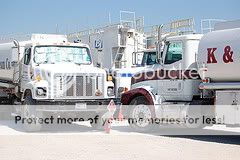Whenever I drive anywhere with my dad, I get a live update on the state of the transport industry. He drove semi trucks for a while during his early years of high school teaching, so he has a keen eye for unusual presences on the highway. Where the average driver (me) sees only a blur of things that should not be collided with, my Dad sees tri-axels, belly-dumps and flatbeds, all “good signs for the economy.” For several years now, he has been flabbergasted at the ever-increasing incidence of a new type of vehicle on
 |
| from photobucket.com |
The Marcellus Shale drilling industry has been booming in Appalachian Pennsylvania,
The extraction of fossil fuels is problematic no matter where or how it is done. The giant spills are the ones that stick in our minds – the Deepwater Horizon leak in the Gulf of Mexico, the Exxon Valdez in
 |
| photobucket.com |
First a vertical well is drilled, just as you might expect. No big deal there. Then a horizontal well goes out from there, usually 4,500 feet. A little strange, but still okay. Then, six to eight million gallons of water, pumped straight out of local rivers until they run dry, is forced into the ground at such phenomenal pressure that the earth literally shatters – rock buried by thousands of feet of other rock and soil, is blasted to pieces! Oh, and that water contains 60-80 thousand gallons of chemicals. Some of them reduce friction so that the water can be pumped in more quickly. Others act as surfactants or serve to wedge open the fissures formed so that natural gas can escape. These are chemicals like diesel fuel, hydrochloric acid and benzene – insanely harmful substances! Benzene is toxic in parts per trillion, let alone parts per million, as it is found in some fracking fluid.
Those horizontal wells go out in all directions from the main well and cover dozens of acres. The total subterranean destruction is enough to cause earthquakes, and it’s terribly unpredictable. The fracking process has been equated to trying to hammer a dinner plate into equal pieces. Sometimes a fracture is intended to go 1000 feet and it goes 400, or 2000.
When a well is exhausted, the fact that an unknown area of earth is now toxified and that ground water has been drilled through is not enough to warrant more than a simple cap. There have been, and will continue to be, contaminations of drinking water. At present, the scale of drilling is only increasing. Must there be a disaster of Gulf Oil Spill proportions to draw attention to what’s happening here? Come to think of it, would that even get anything accomplished? Somehow profit for these few states is powerful enough to hide a clear and definite threat for public and environmental safety. We’re literally pumping poison into our water because it’s the profitable thing to do.

Okay, so, maybe I'm in edit mode, but your first paragraph really compels me to keep reading.
ReplyDeleteAlso, where did you find info on what chemicals are in hydrofracking liquid? I have had trouble finding the specific chemicals that are used.
I had trouble finding stuff about specific chemicals used in Marcellus drilling as well, probably because of that "trade secret" balogna. Most of what the public knows about fracking chemicals seems to come from the drilling that has already been done in the West. At any rate, I got a ton of good information from this site: http://www.un-naturalgas.org/
Delete